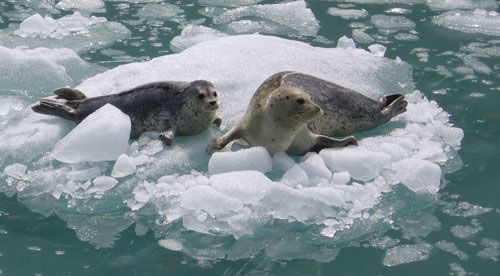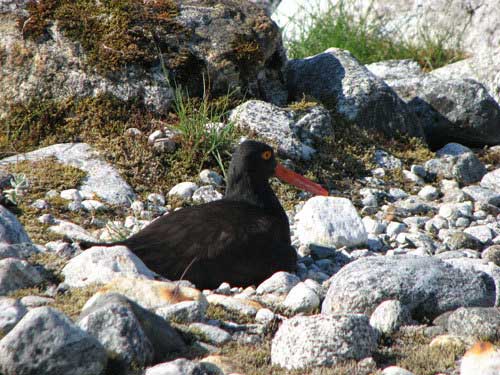 Story and photos TIM LYDON July 24, 2010
I'm perched on a ledge about 400 feet above an ice-choked Tracy Arm, and the seal is lying on a berg in the middle of the fjord. She's more than a mile away, but I'm guessing that her constant repositioning means she's in labor. Then it happens. The ice berg turns red, and when the mother shifts again I see she is no longer alone. A tiny pup lies beside her. The mother cranes her neck to touch noses with her newborn, imprinting its scent. The news spreads fast. Within a couple minutes, two big bald eagles descend on the berg with outstretched wings. Four ravens quickly arrive, and a couple gulls circle above. The birds jockey for fresh afterbirth, but the mother keeps them at bay with repeated charges. Each time the birds hop backward, she urges her pup toward the far end of the berg. Eventually, she shoves the pup into the icy water, then slips off the berg herself. Mom and pup surface a moment later, then swim away together. Each June, pregnant harbor seals travel to the ends of Tracy and Endicott Arms Wilderness Area to give birth. Between 500 and 1,000 seals gather in each arm, about a third of them mothers-to-be. By mid-June, the fiords echo with the raspy calls of newborn pups. They shadow their mothers for about three weeks, spending long hours nursing atop flat bergs.  Photo by Tim Lydon
In general, the ends of the fjords are safe places for seals. I've never seen sea lions there, and orcas are rare visitors. However, rising vessel traffic in recent years has increased pressure. Eager for up-close views, captains too often crowd mothers and pups, spooking them from their bergs. Research shows that seal pups in glacial fiords are sensitive to the disturbance. Added time in the cold water burns calories, inhibiting growth and reducing chances for survival. As funny as it sounds, lying on platforms of ice keeps young seals out of the cold. Boaters in the fiords can help the seals by giving them space and recognizing signs of stress. Avoid approaching so close that seals become alert and oriented toward you, as it usually means they are about to abandon their berg. Kayakers should use the same precautions, as they can displace seals from greater distances than even mid-size motor boats. The nice thing about kayaking is that it's easy to watch the seals from shore, where most of my best observations have occurred. For many, the seals are the big draw to Tracy and Endicott Arms in June. But the fjords are full of new life at this time of year, and not just near the glaciers.  Photo by Tim Lydon
And then there are the birds. Along gravelly beaches, plovers fake broken wings to lead intruders away from their young. In nearly every calm lagoon, ducklings trail single-file behind mergansers and harlequins. Pairs of oystercatchers, high-adventure nesters who raise their young close to the tide line, peep frantically at trespassing ravens. From tall snags in the forest, woodpecker chicks cry out incessantly as their parents hunt for food. On an island in Holkham Bay, we find what might be the busiest bird on Earth, a mother kinglet with a clutch of seven. All day, she captures insects among the spruce and hemlocks, making frequent deliveries to her young. They huddle wing-to-wing at the base of a spruce branch, their high-pitched cries keeping the mother on a feeding frenzy. Above, crows and eagles slice the air with big wings, carrying on their own hunts. For the tiny kinglets, it must be like living among dinosaurs. For some groups of Tlingit who live here, June was called the "birthing moon" in recognition of the arrival of new animals. It's an apt name for this time of year in Tracy Arm-Fords Terror Wilderness. Along with all the new life, long days and calm conditions make it a great time for a visit.
Editor's note: This is the second in a series of articles about Alaska's remote forests, as seen through the eyes of a wilderness ranger.
Source:
Publish A Letter in SitNews Read Letters/Opinions
|